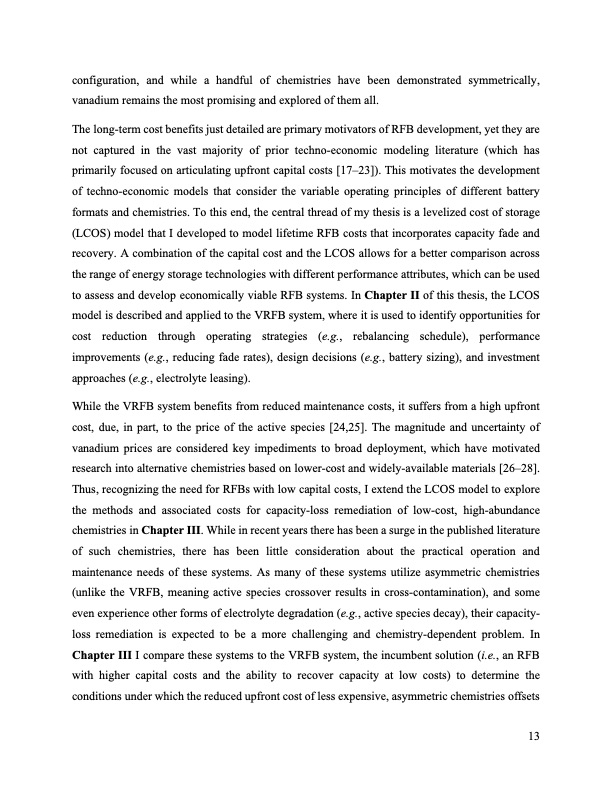
PDF Publication Title:
Text from PDF Page: 013
configuration, and while a handful of chemistries have been demonstrated symmetrically, vanadium remains the most promising and explored of them all. The long-term cost benefits just detailed are primary motivators of RFB development, yet they are not captured in the vast majority of prior techno-economic modeling literature (which has primarily focused on articulating upfront capital costs [17–23]). This motivates the development of techno-economic models that consider the variable operating principles of different battery formats and chemistries. To this end, the central thread of my thesis is a levelized cost of storage (LCOS) model that I developed to model lifetime RFB costs that incorporates capacity fade and recovery. A combination of the capital cost and the LCOS allows for a better comparison across the range of energy storage technologies with different performance attributes, which can be used to assess and develop economically viable RFB systems. In Chapter II of this thesis, the LCOS model is described and applied to the VRFB system, where it is used to identify opportunities for cost reduction through operating strategies (e.g., rebalancing schedule), performance improvements (e.g., reducing fade rates), design decisions (e.g., battery sizing), and investment approaches (e.g., electrolyte leasing). While the VRFB system benefits from reduced maintenance costs, it suffers from a high upfront cost, due, in part, to the price of the active species [24,25]. The magnitude and uncertainty of vanadium prices are considered key impediments to broad deployment, which have motivated research into alternative chemistries based on lower-cost and widely-available materials [26–28]. Thus, recognizing the need for RFBs with low capital costs, I extend the LCOS model to explore the methods and associated costs for capacity-loss remediation of low-cost, high-abundance chemistries in Chapter III. While in recent years there has been a surge in the published literature of such chemistries, there has been little consideration about the practical operation and maintenance needs of these systems. As many of these systems utilize asymmetric chemistries (unlike the VRFB, meaning active species crossover results in cross-contamination), and some even experience other forms of electrolyte degradation (e.g., active species decay), their capacity- loss remediation is expected to be a more challenging and chemistry-dependent problem. In Chapter III I compare these systems to the VRFB system, the incumbent solution (i.e., an RFB with higher capital costs and the ability to recover capacity at low costs) to determine the conditions under which the reduced upfront cost of less expensive, asymmetric chemistries offsets 13PDF Image | Bringing Redox Flow Batteries to the Grid

PDF Search Title:
Bringing Redox Flow Batteries to the GridOriginal File Name Searched:
Rodby-krodby-phd-chemE-2022-thesis.pdfDIY PDF Search: Google It | Yahoo | Bing
Salgenx Redox Flow Battery Technology: Salt water flow battery technology with low cost and great energy density that can be used for power storage and thermal storage. Let us de-risk your production using our license. Our aqueous flow battery is less cost than Tesla Megapack and available faster. Redox flow battery. No membrane needed like with Vanadium, or Bromine. Salgenx flow battery
| CONTACT TEL: 608-238-6001 Email: greg@salgenx.com | RSS | AMP |